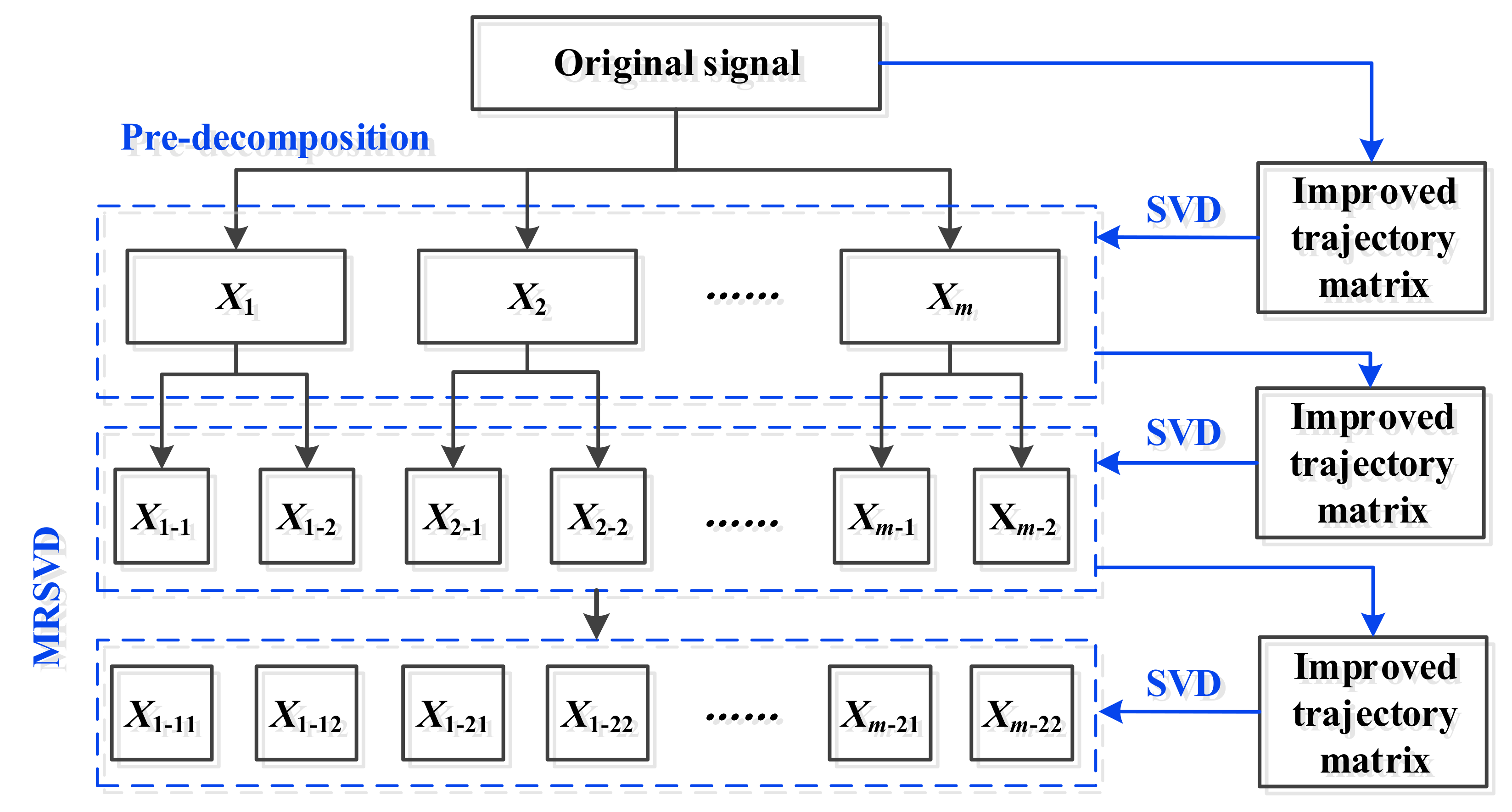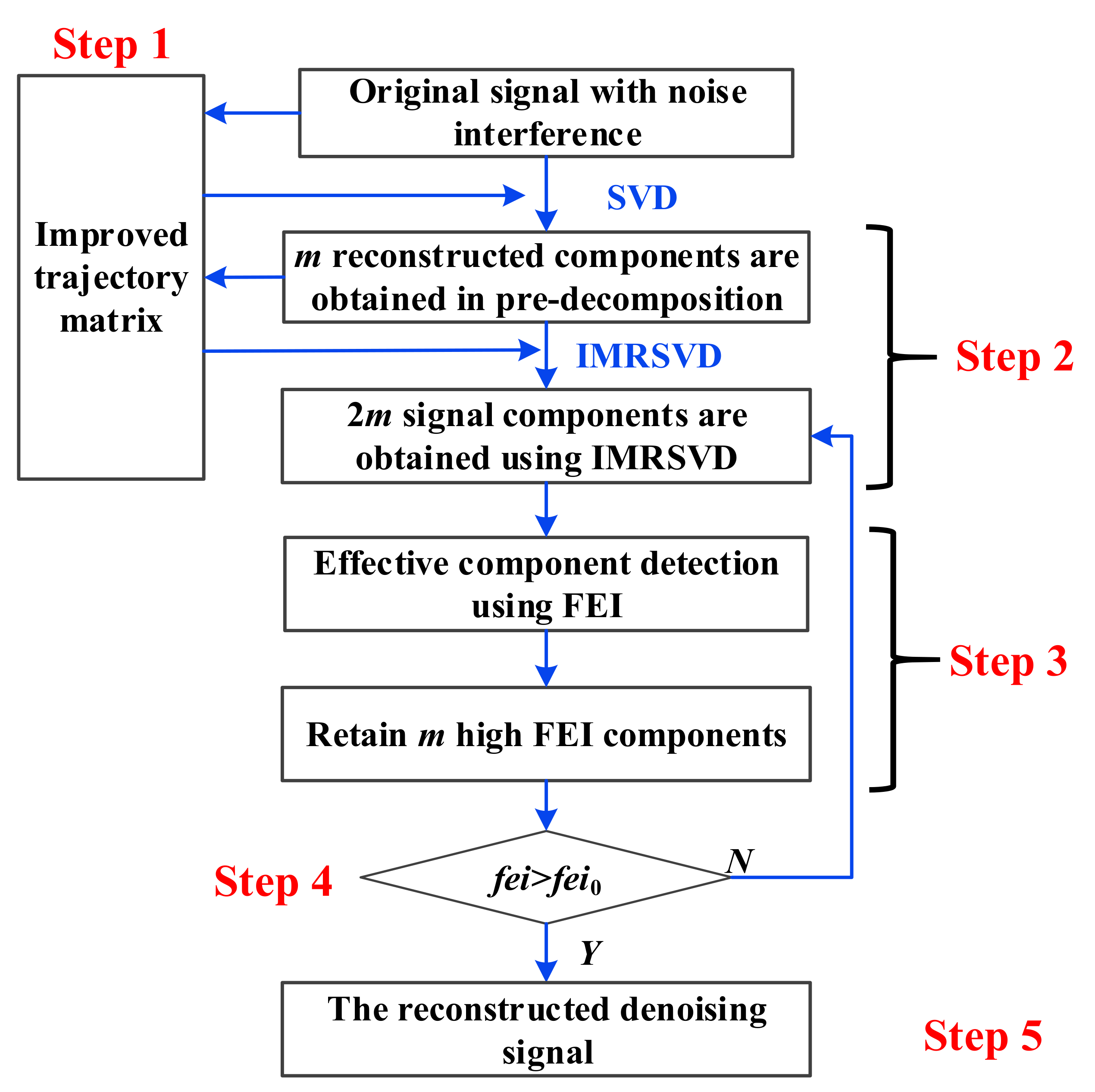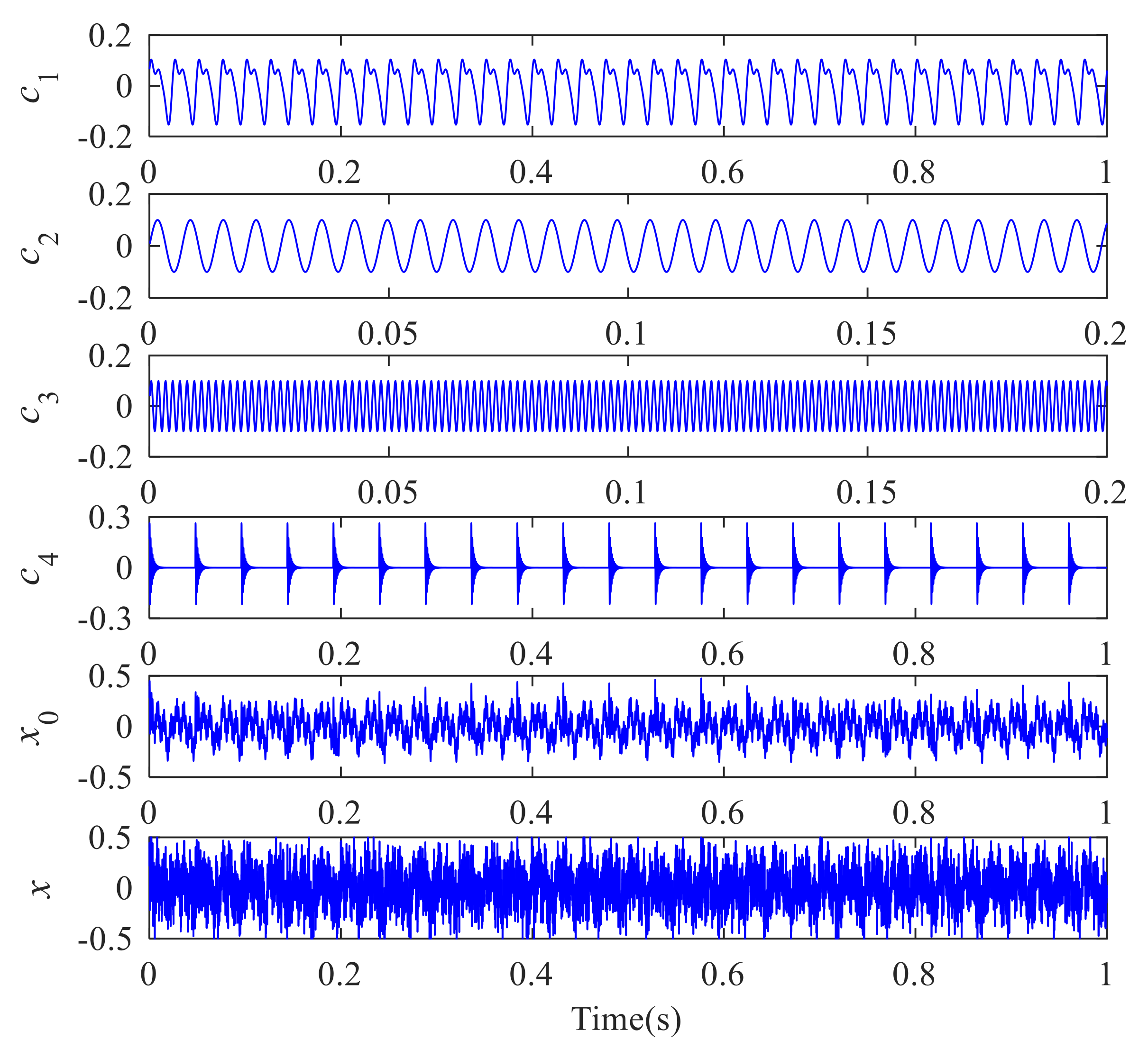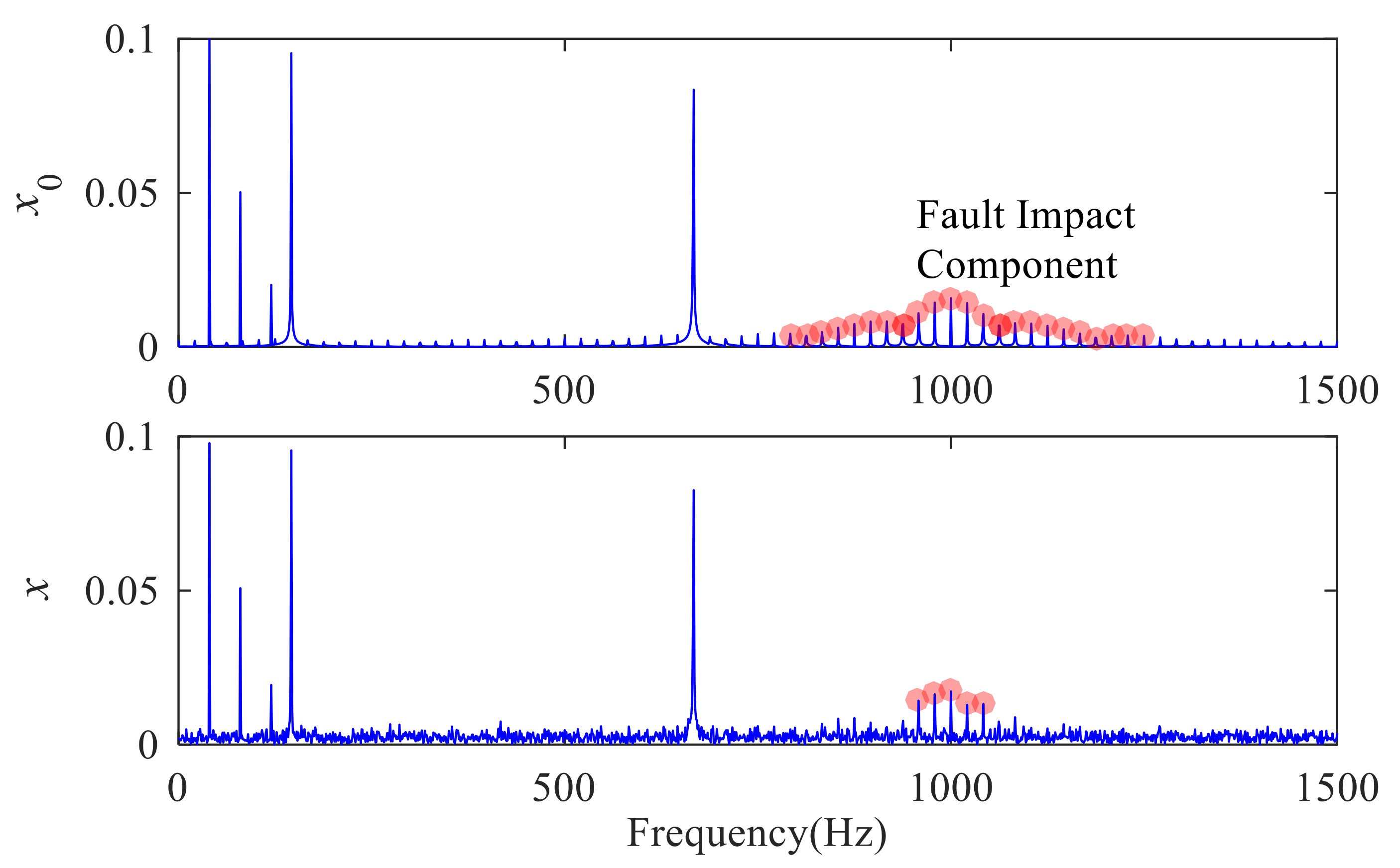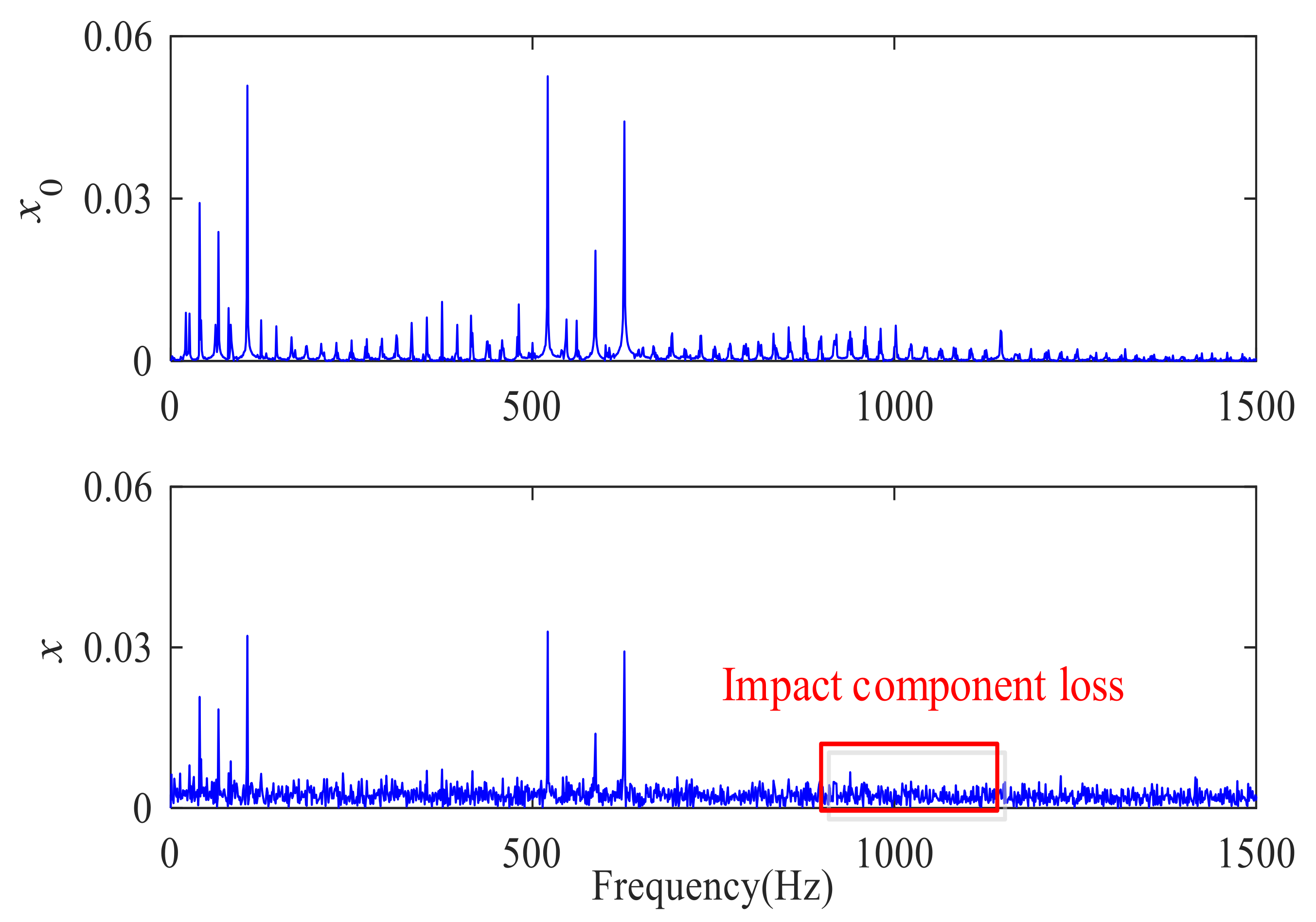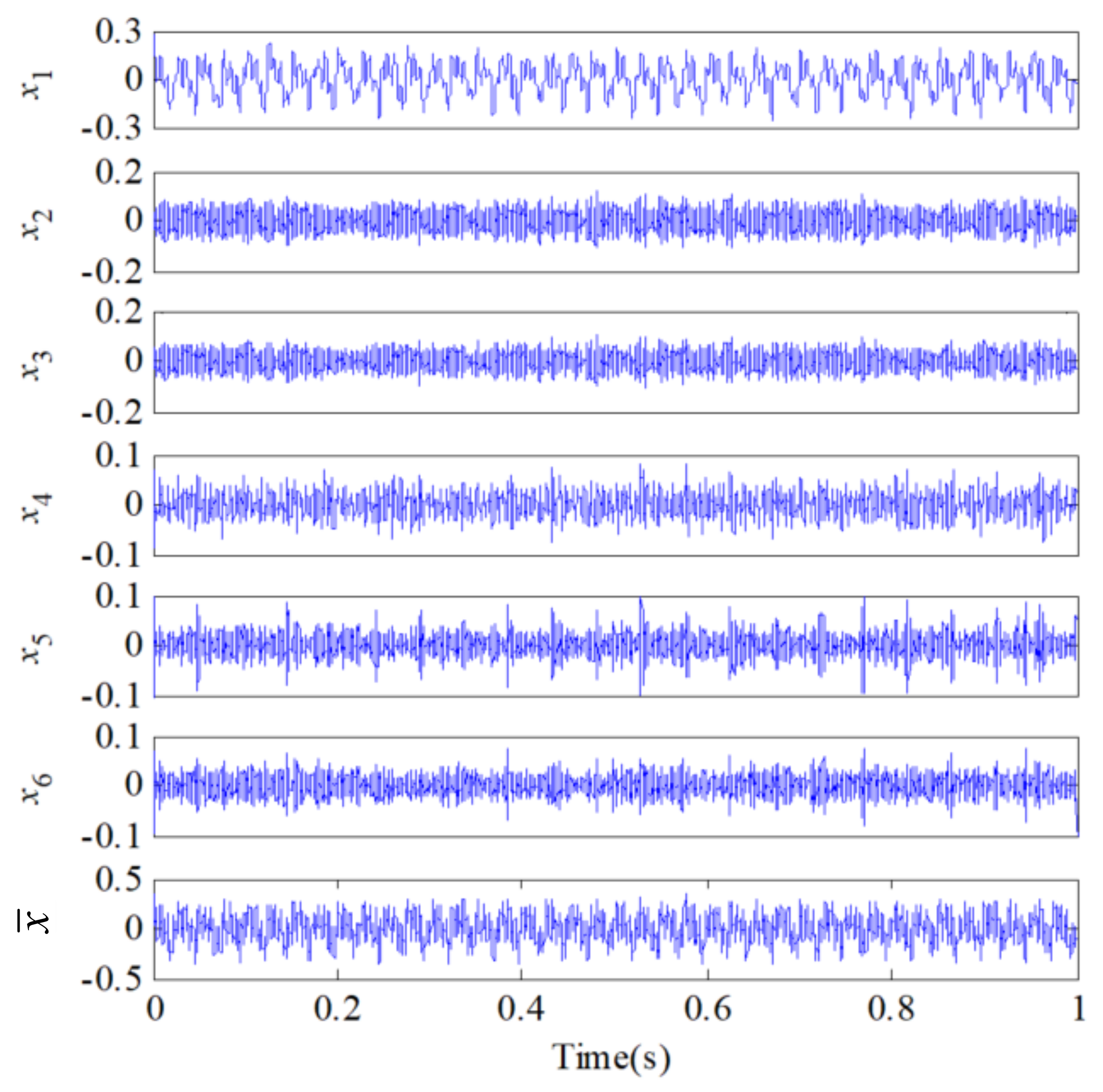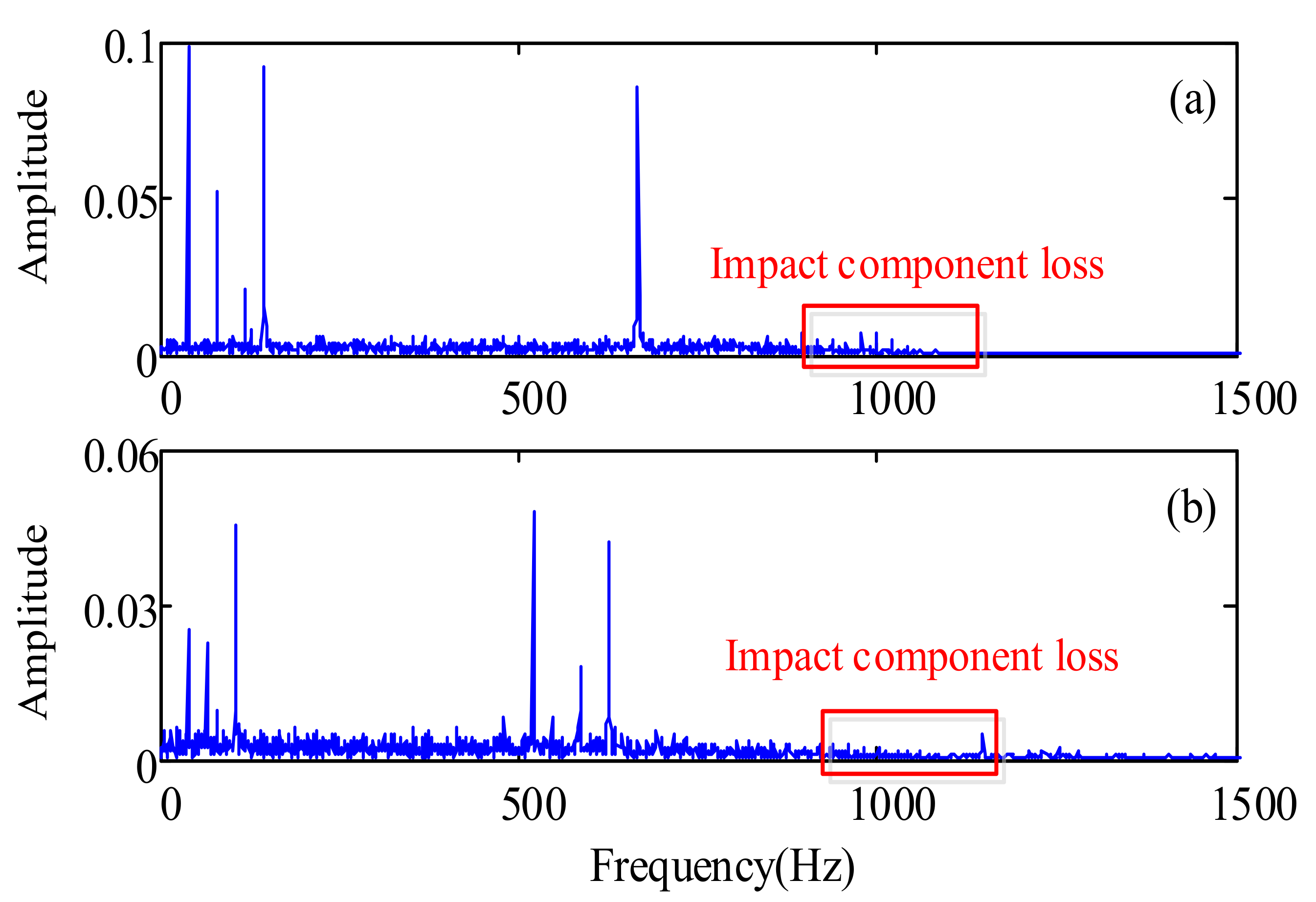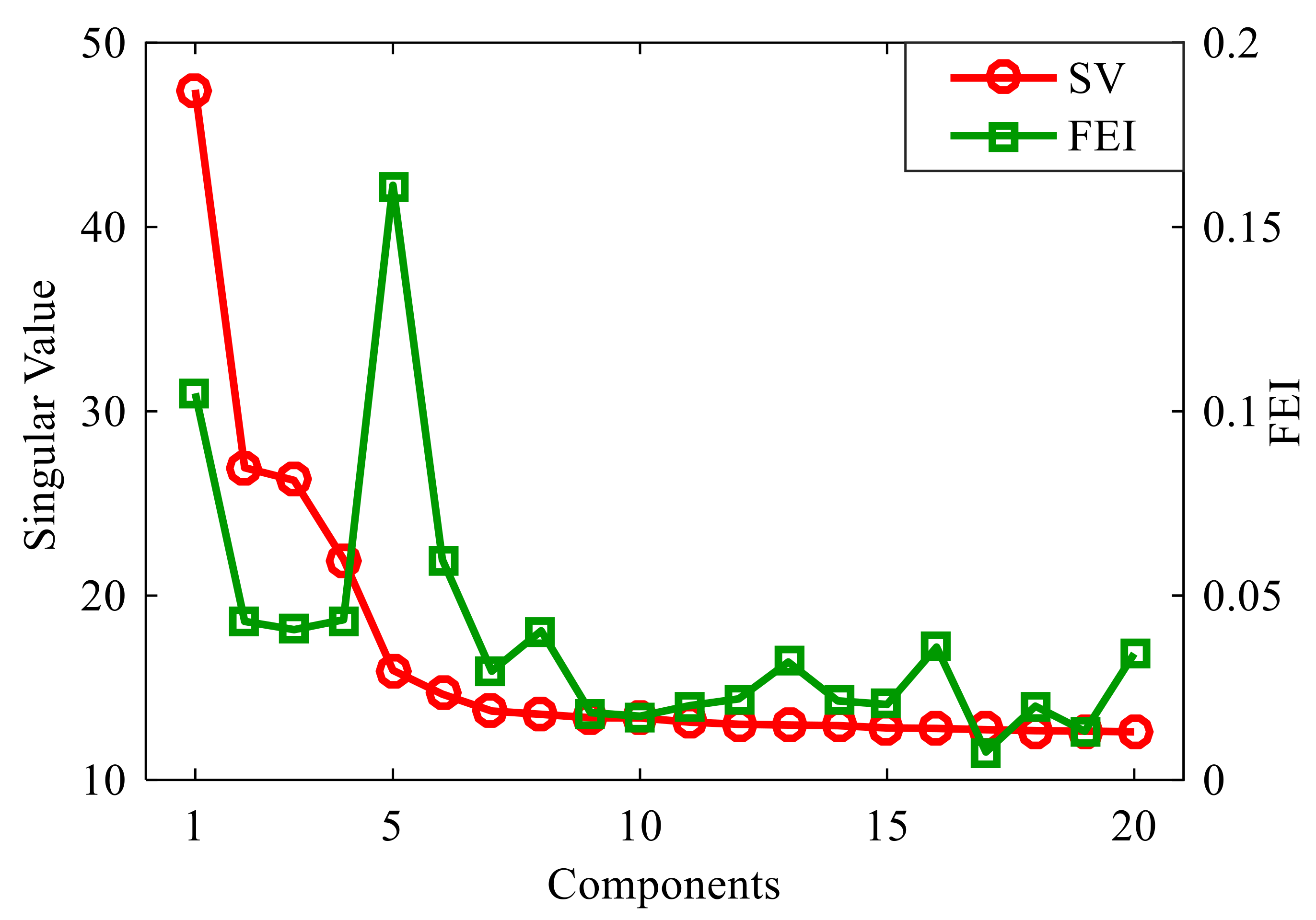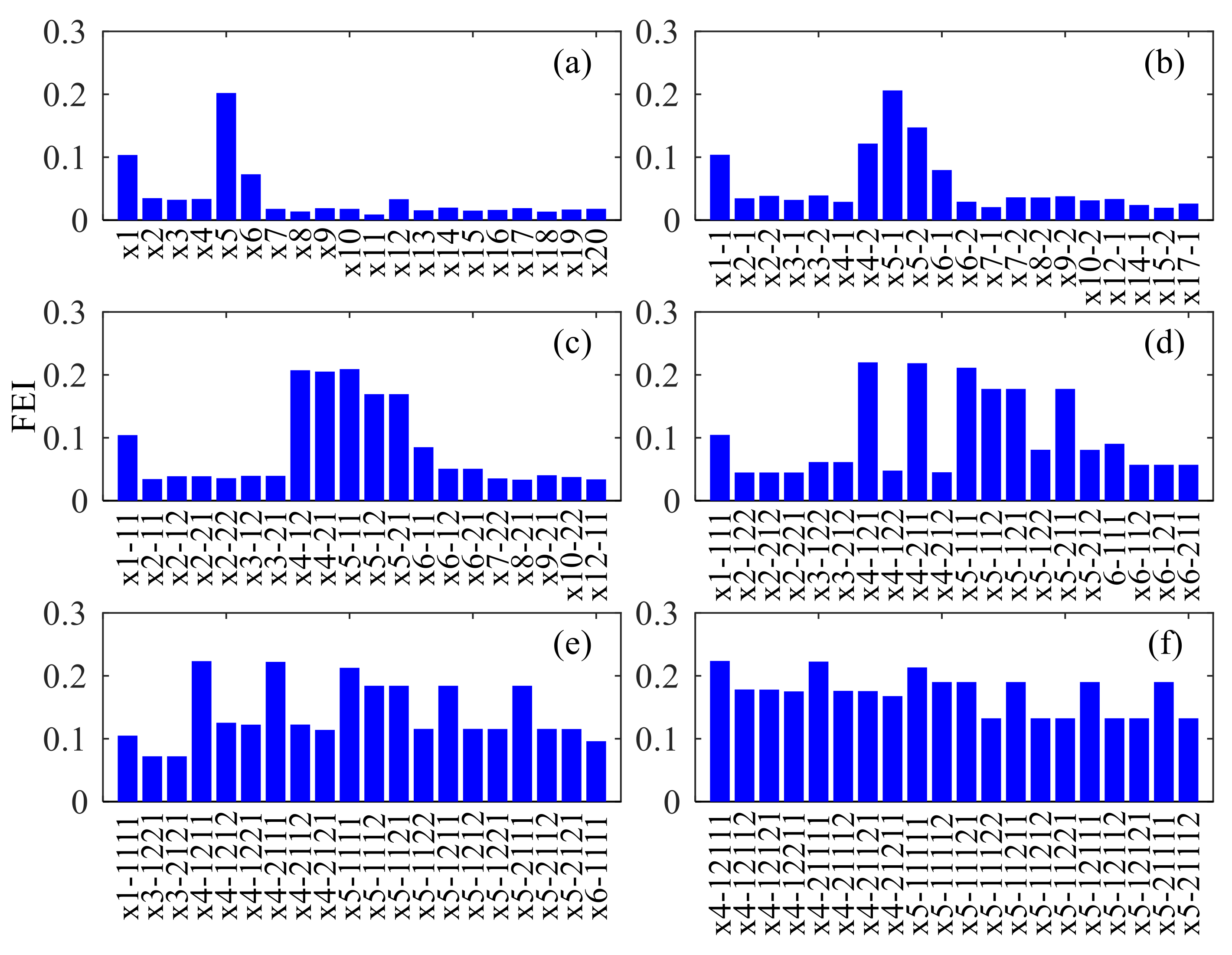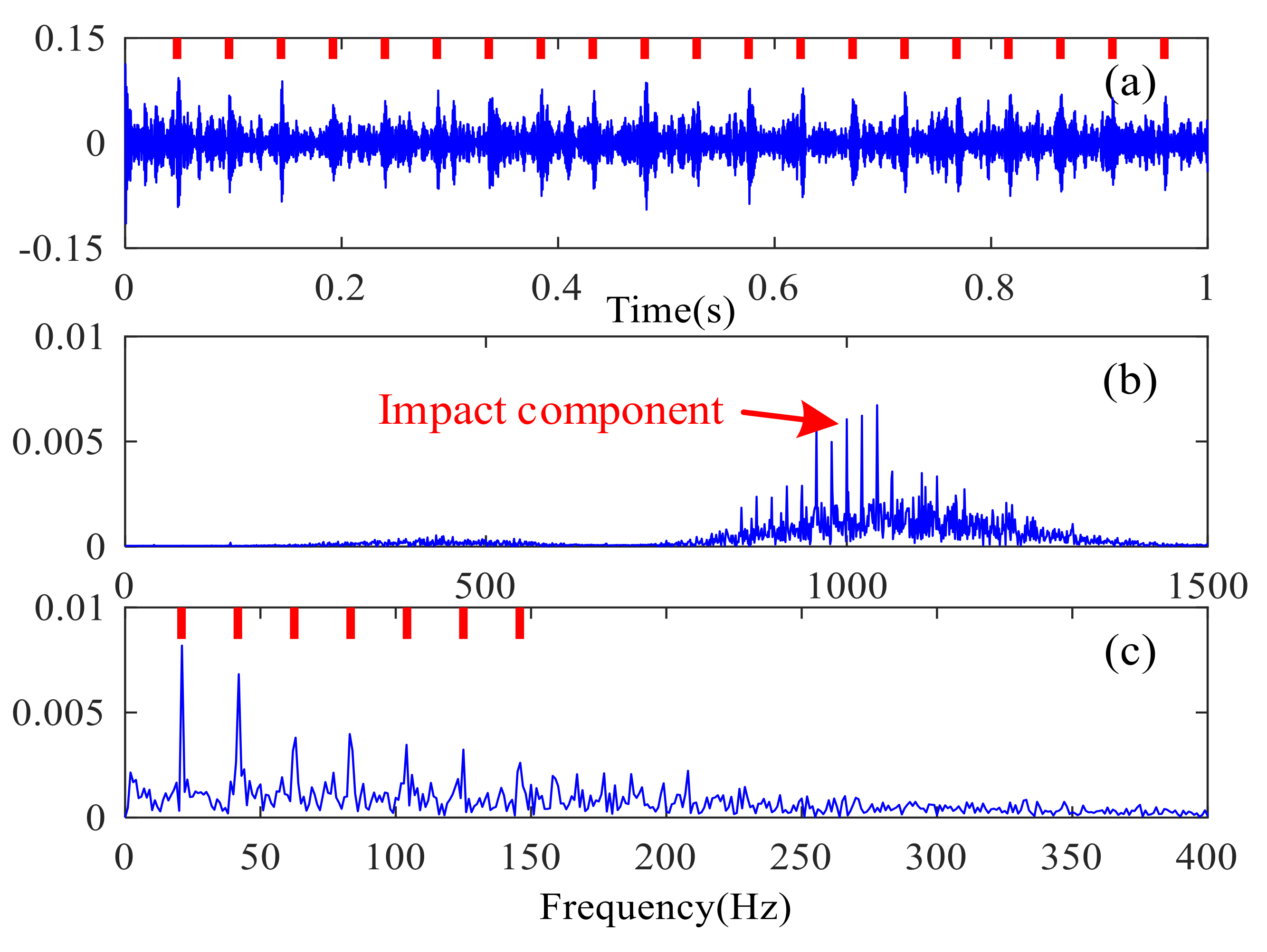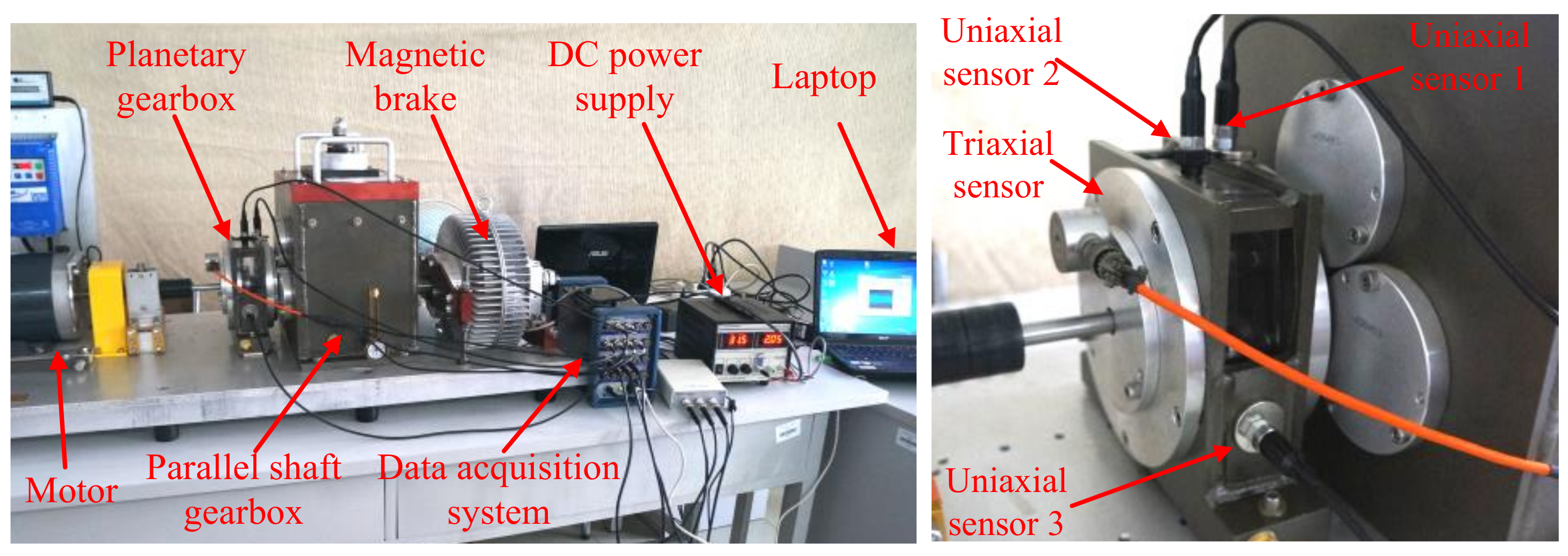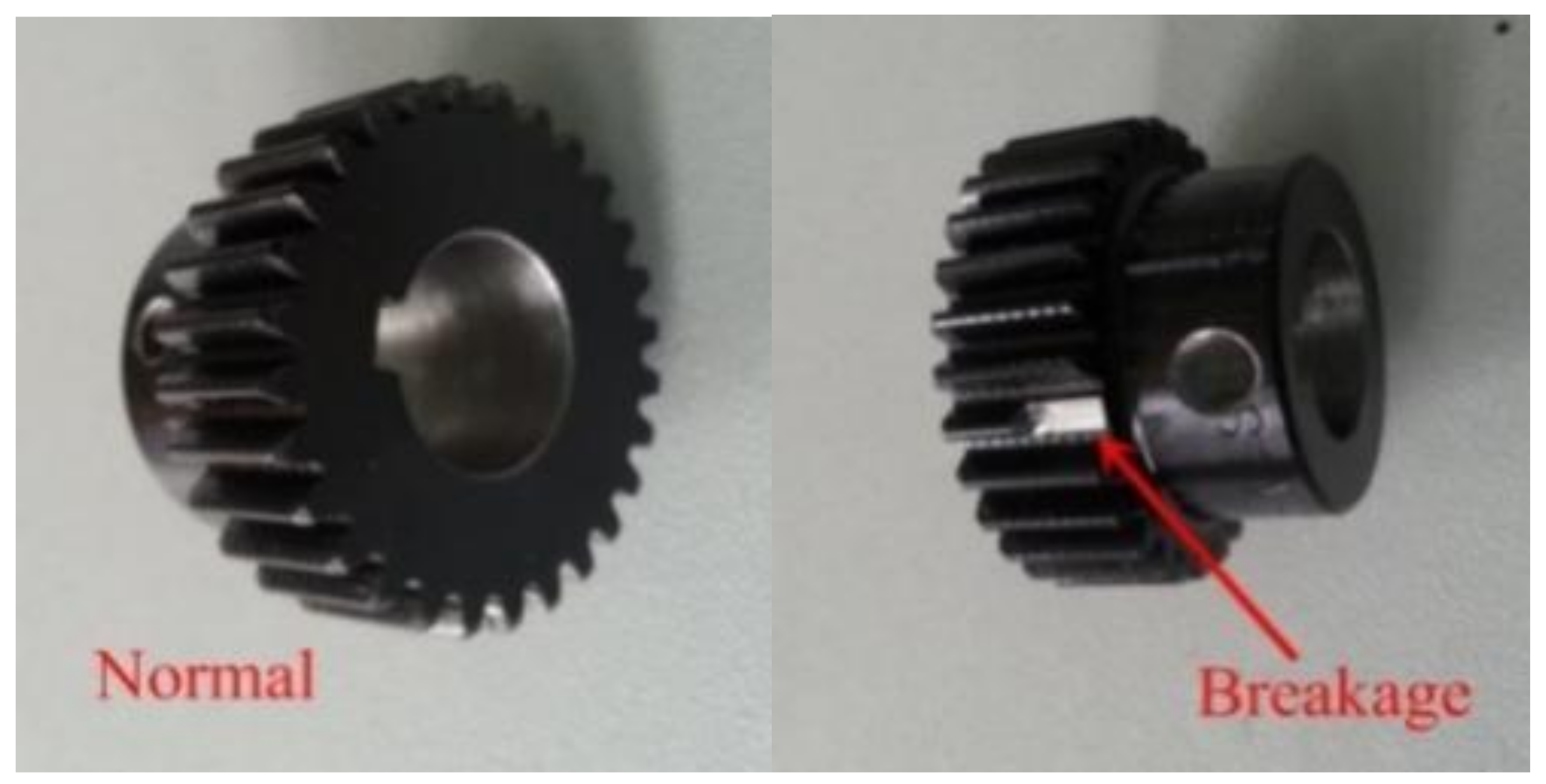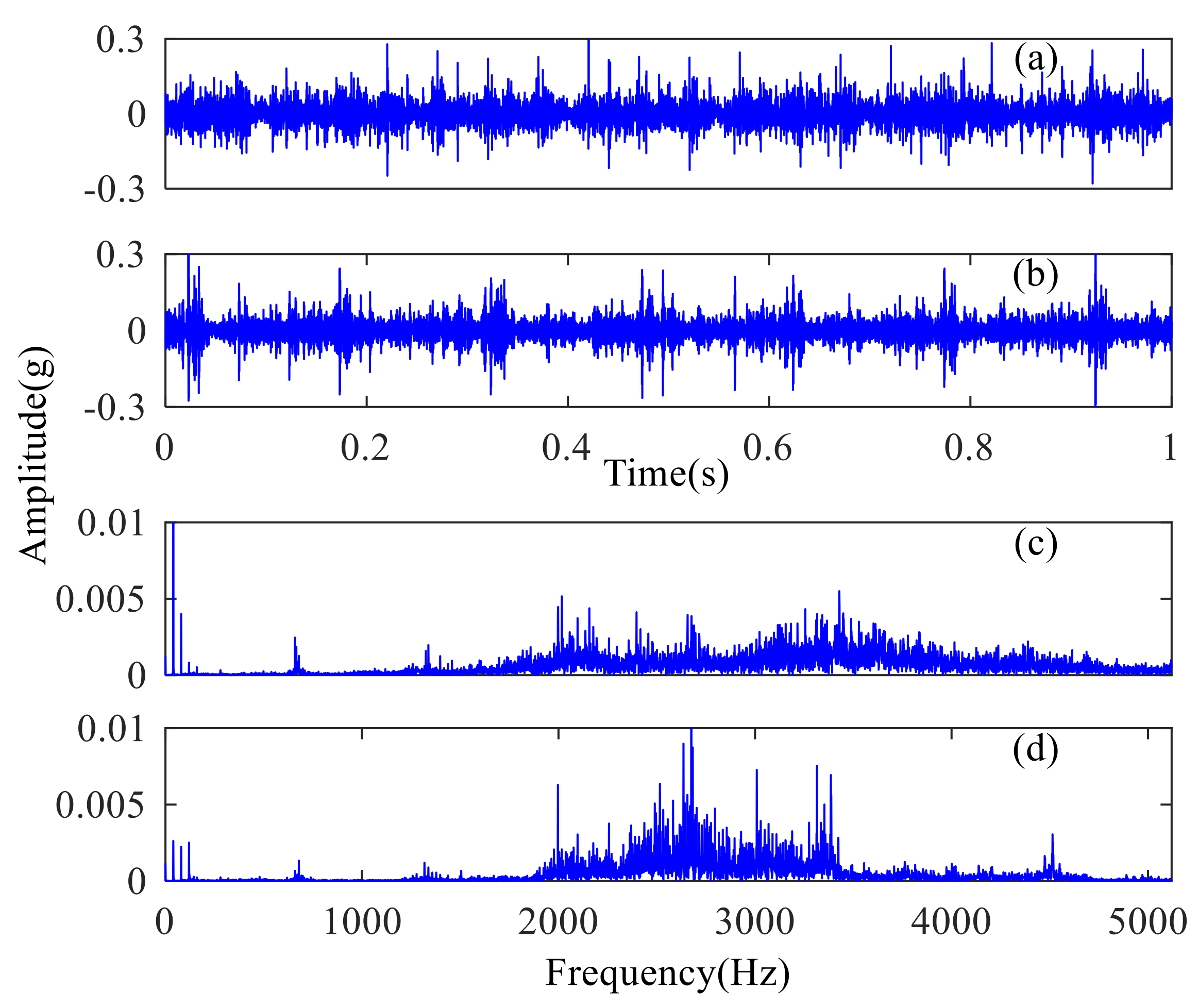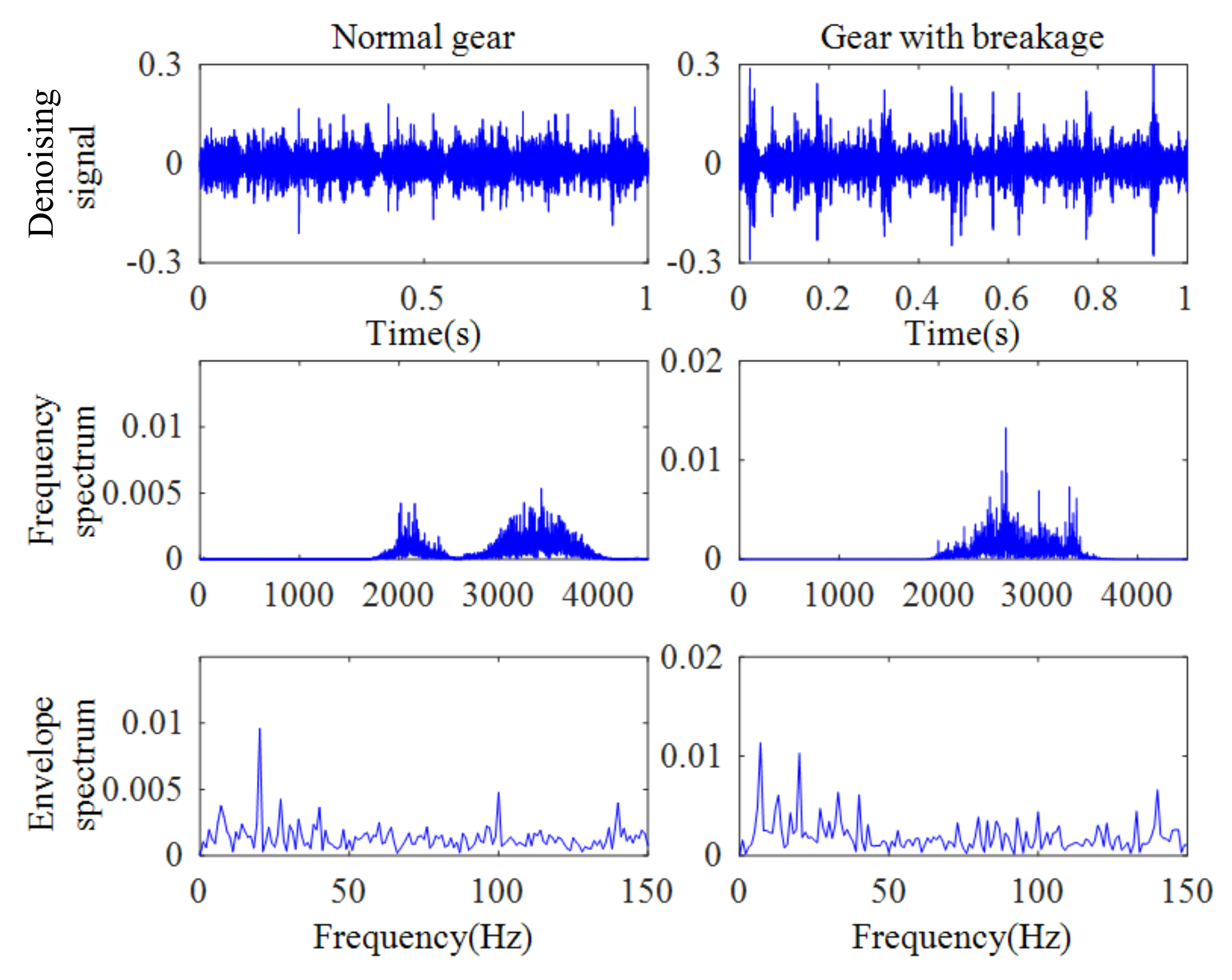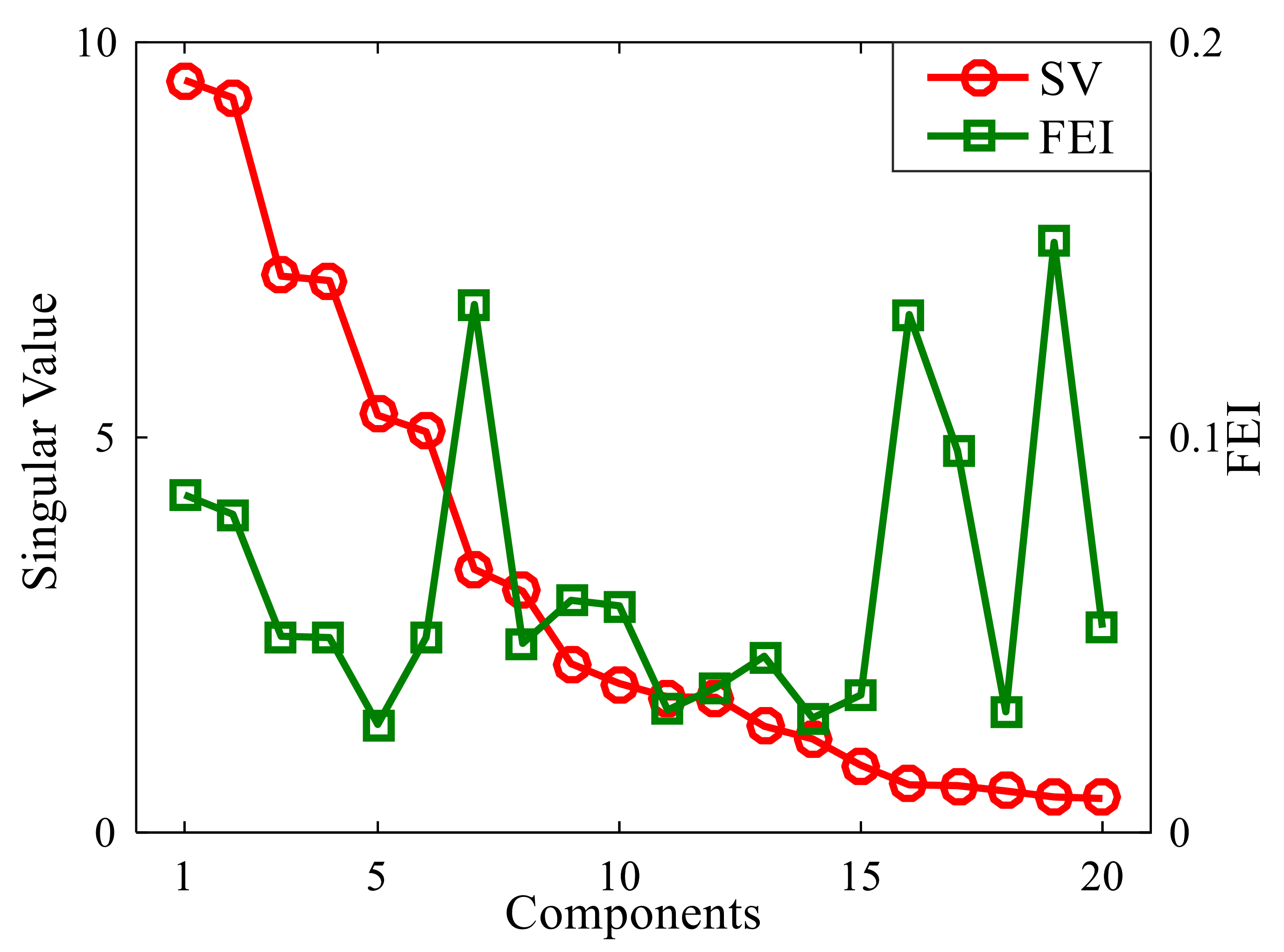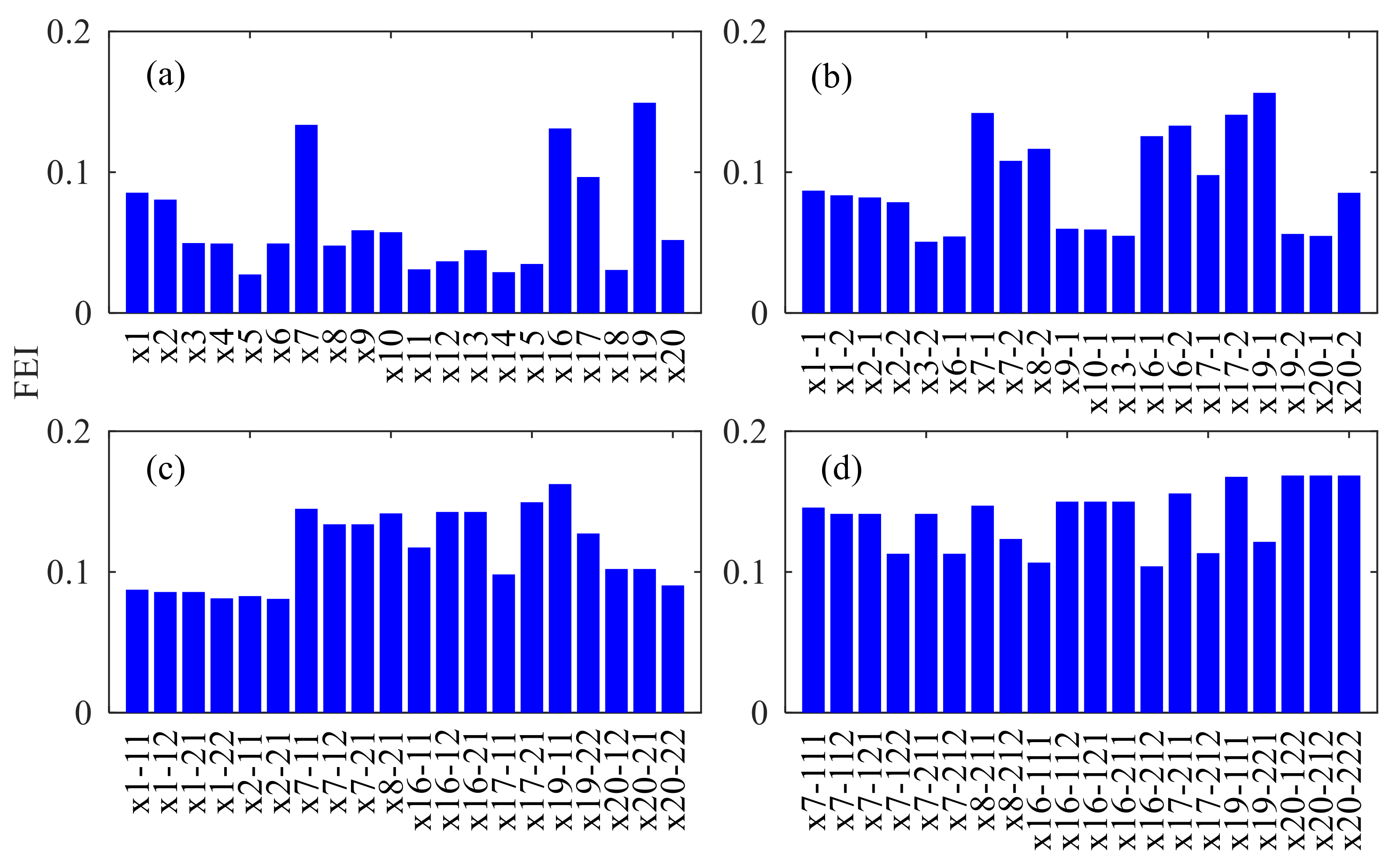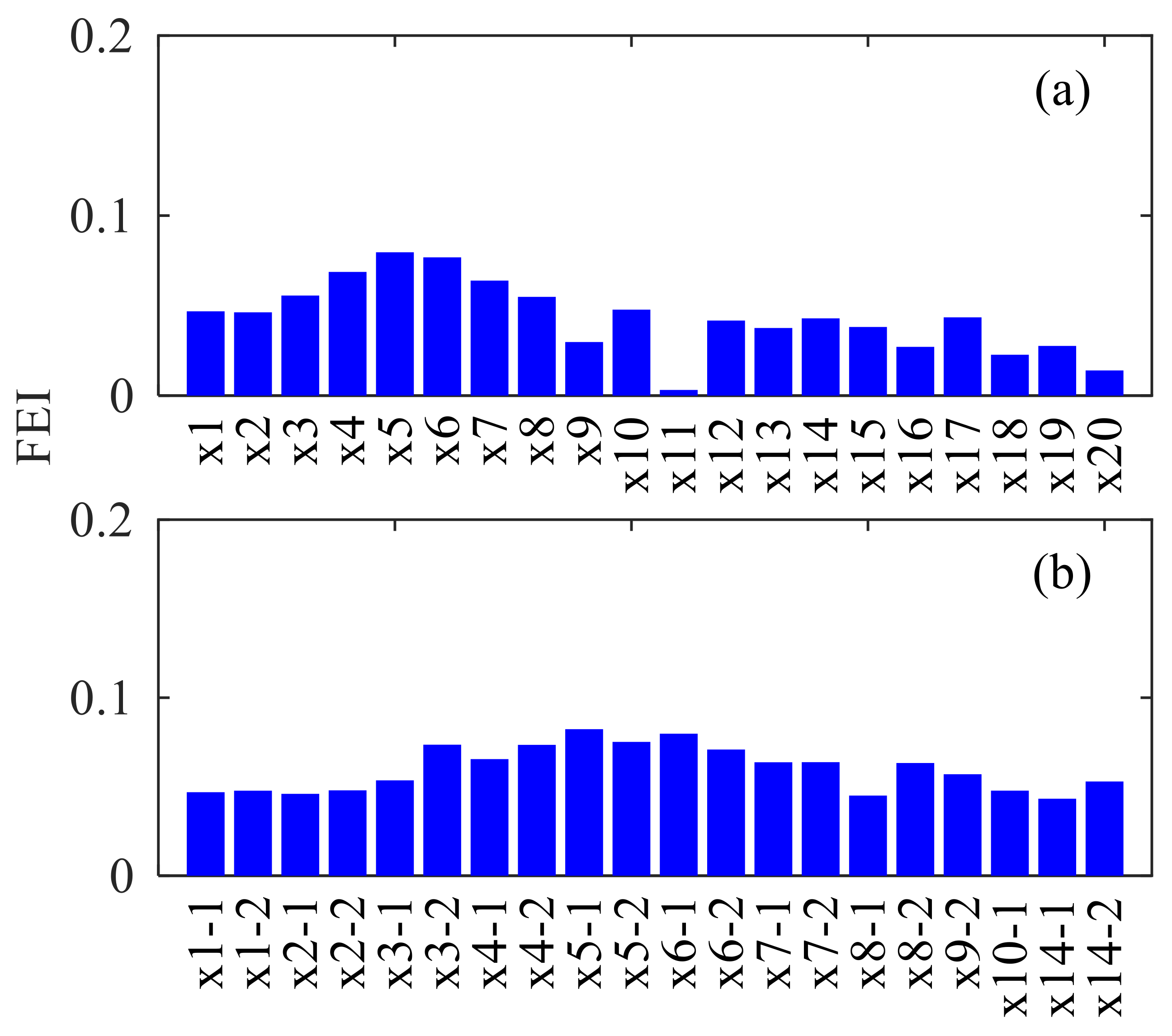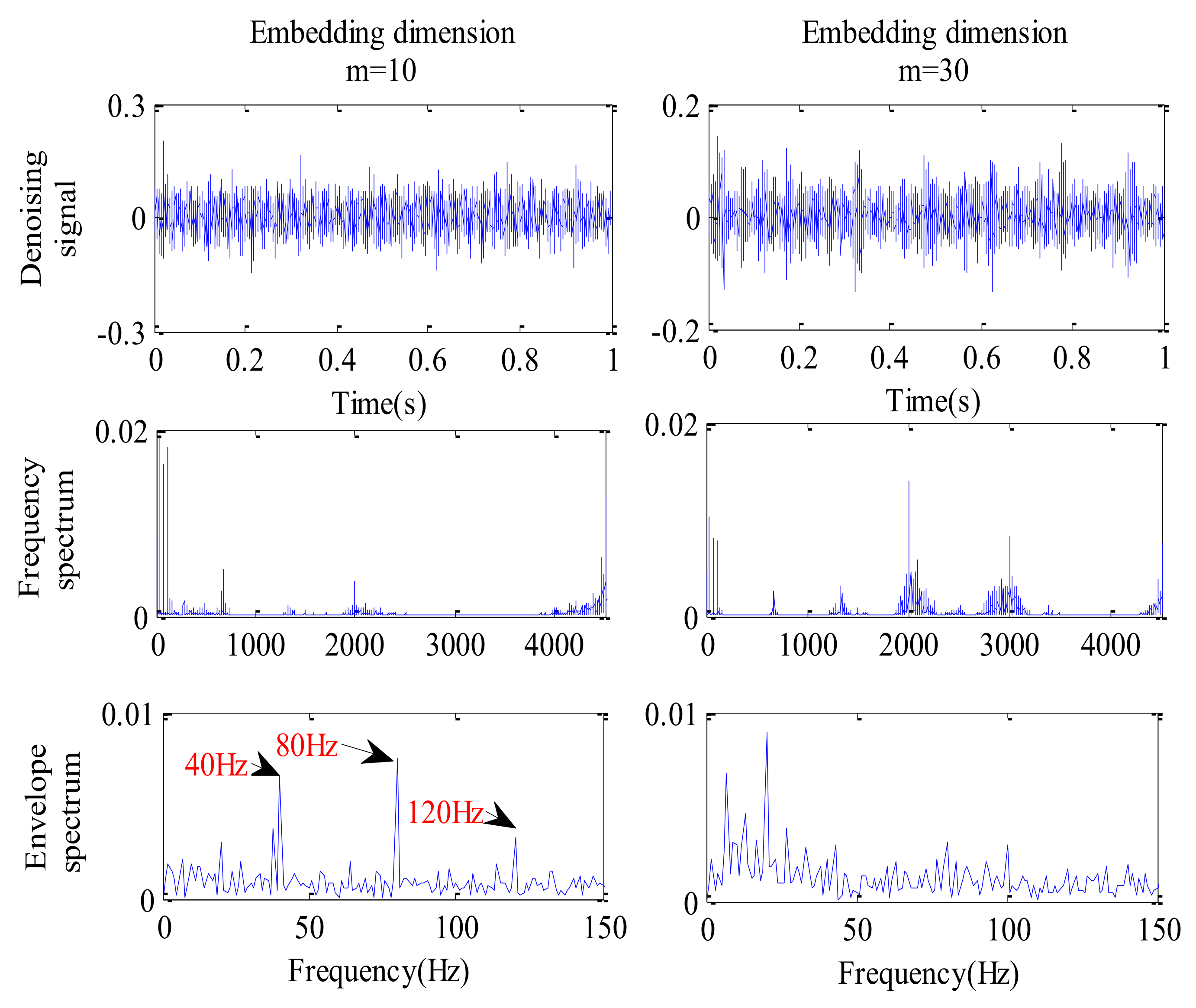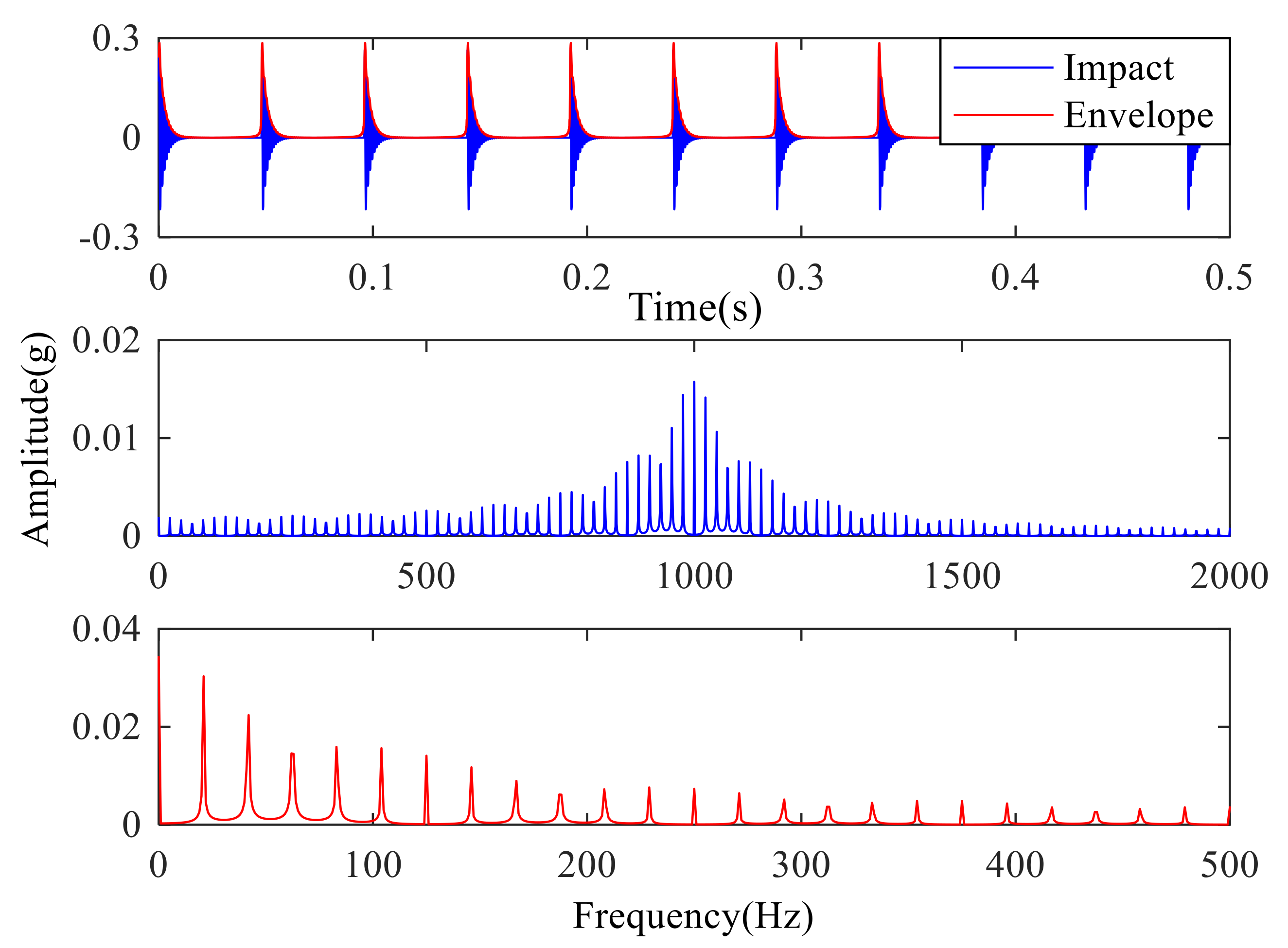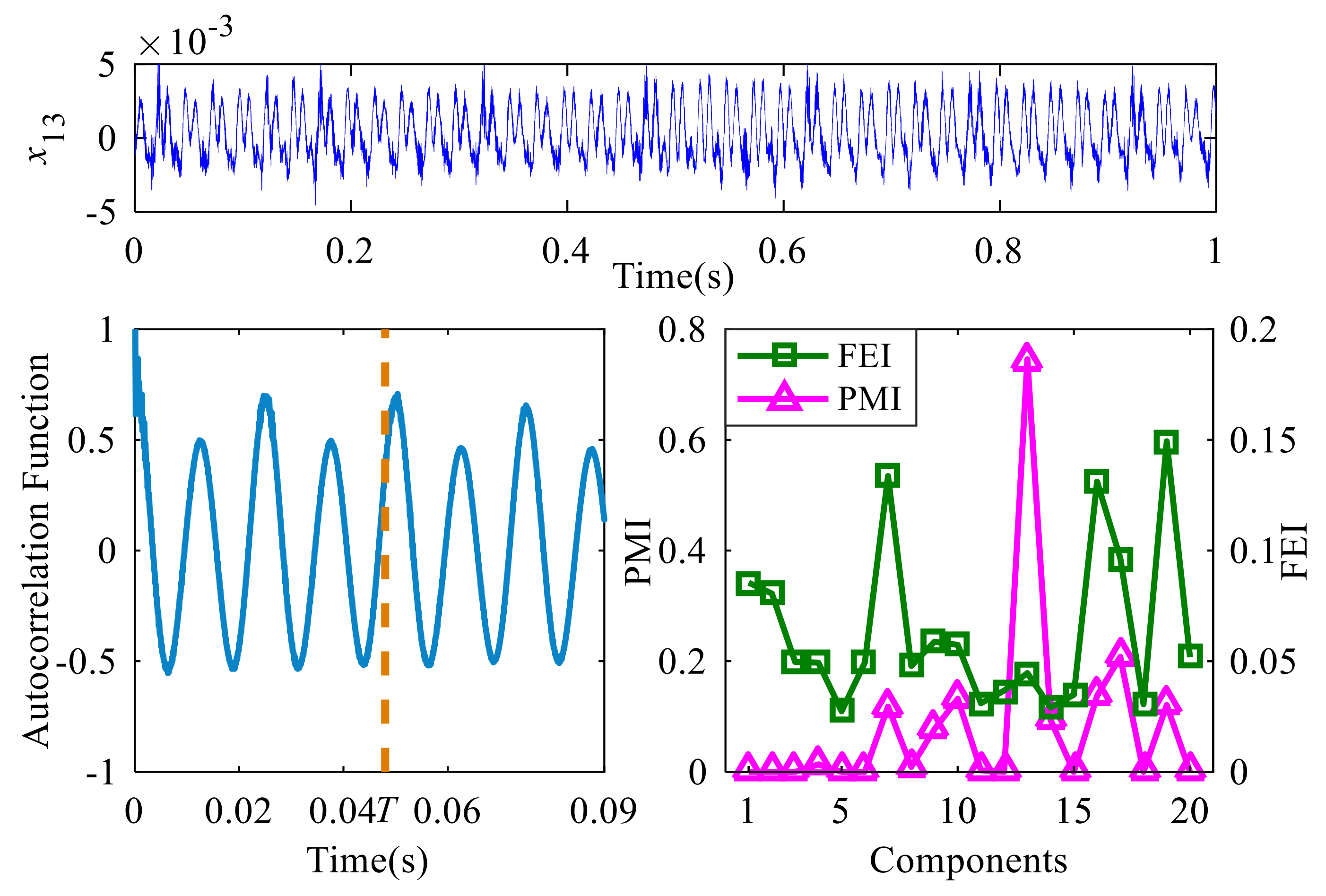1. Introduction
Nowadays, gear is the most important transmission device in mechanical equipment, and its fault diagnosis research is of great significance to ensuring equipment safety and operation [
1]. Vibration signal analysis is a widely accepted fault diagnosis tool for mechanical equipment [
2]. By analyzing feature information in vibration signals, the early faults can be diagnosed while economic losses and casualties can be avoided. However, the harsh working conditions of the gear cause the vibration signal to contain a lot of noise and interference components. The fault feature information is generally covered by noise interference, and the accurate diagnosis result is hard to be gained directly [
3]. Therefore, it is necessary to study the preprocessing denoising method for vibration signals which can effectively eliminate noise interference and retain fault information.
After years of development, many signal processing methods and theoretical models have been used for signal denoising and weak fault feature extraction, such as dynamic analysis [
4], computational fluid dynamics [
5], wavelet transform [
6,
7], adaptive time-frequency decomposition [
8,
9], blind source separation [
10,
11], singular value decomposition (SVD) [
12], stochastic resonance [
13,
14], and deconvolution-based methods [
15,
16]. In addition, their improved methods and other sensor detection methods have also been explored and studied for better performance. Osornio-Rios [
17] is based on the infrared measurement system. The classification and recognition of various faults in the transmission chain are realized through preprocessing, statistical feature extraction, high-dimensional feature generation, and feature reduction. Zamudio-Ramirez [
18] proposed a diagnosis method by analyzing stray flux signals. Statistical time domain-based features, principal component analysis, and neural networks are used to identify the uniform wear of gear. In the aspect of the vibration signal process, Hu [
19] extracted the bearing fault features using a ridge extraction algorithm based on dynamic path optimization and enhanced empirical wavelet transform. The experimental results demonstrate that the proposed method is robust to noise and effective for bearing fault detection under variable speed conditions. Xiao [
20] proposed a digital speckle pattern interferometry phase denoised method based on improved variational mode decomposition, which can effectively filter out noise interference. Hu [
21] introduced the dual-tree complex wavelet transform into the multiscale noise tuning stochastic resonance method to improve the signal-to-noise ratio of the signal. Laha [
22] proposed a modified nonlocal means denoising algorithm for the rolling element bearing fault diagnosis. The proposed method is compared with minimum entropy deconvolution, and the results show that it is robust against various noise levels.
Among the above methods, SVD is concerned and studied. SVD is a kind of matrix orthogonalization decomposition method which can effectively reflect some properties of matrices. Because of its remarkable effect in signal denoising and feature information extraction, it is applied to fault detection as well as many other fields [
23,
24]. Ye [
25] presented a novel K times singular value decomposition-based denoising algorithm to separate the Gaussian noise from the division-of-focal-plane image and preserve the details. Yi et al. [
26] proposed a quaternion singular spectrum analysis method based on convex optimization. The useful signal and noise can be distinguished by quaternion singular value decomposition to augmented trajectory matrix. Zhao et al. [
27] proposed a reweighted singular value decomposition strategy. A novel information index was introduced to quantify the diagnostic information, and a truncated linear weighting function was used to control the contribution of each component during the denoised signal reconstruction. The results show that the weak fault feature with heavy noise and environmental interferences can be extracted successfully. Traditional SVD denoising can achieve good results under ideal conditions. However, in harsh working conditions, the denoising effect can be affected, and the weak fault information is easy to be lost [
28,
29]. These remaining problems restrict the practical application of the method, and further improvement is needed.
In this paper, a new denoising method is proposed. Combined with IMRSVD and FEI, effective signal components can be selected to reconstruct the denoising signals. The simulation and experimental results show that the proposed method performs better than the traditional SVD denoising method. The weak fault feature components in the original signal can be effectively preserved. Signal component selection is based on signal-to-noise ratio rather than signal energy. The process of decomposition and reconstruction is simple and complete, with fewer parameters to be set. These are beneficial to the practical application of the proposed method. The remainder of this paper is composed as follows:
Section 2 establishes the mathematical model of the improved denoising method based on IMRSVD and FEI. In
Section 3, the performance of the proposed method is tested by processing the simulation signal, and the results are compared with the traditional SVD denoising method. In
Section 4, the fault signal denoising experiment is carried out, the vibration signals of the gear are processed and analyzed using the proposed method, and the effectiveness is further verified. In the last section, many conclusions are summarized.
2. Model Establishment
2.1. The Basic Theory of IMRSVD
2.1.1. The Improvement of Trajectory Matrix
The construction of the trajectory matrix is the key to the denoising method based on SVD. In this paper, a new construction method of trajectory matrix is applied. Assuming that the time series is
, the data length is
N, and the embedding dimension is set to
m, the one-dimensional time series can be converted into
, where
. For example, if the time series is
, and the embedding dimension
m is set as 4, then the obtained matrix is as follows:
Because the matrix diagonalization before SVD can enhance the oscillation components in the decomposition results of SVD, which contain more feature information and useful signals. The six elements in the lower right corner of matrix
X are placed in the upper left corner to obtain the improved trajectory matrix, and it is as follows:
2.1.2. SVD
SVD [
30] is an effective matrix analysis tool that can be used to decompose and transform a matrix. It can be used to obtain a low-rank matrix to approximate the original matrix. For the improved trajectory matrix
X, the existence of two orthogonal matrices,
and
, allows the following equations to be established [
31]:
where
, and
(
i = 1, 2, …, d) is called the singular value of matrix
X,
r = rank(
X), and
d = min(
m,
n).
Equation (5) is the singular value decomposition of matrix
X. Matrix
U is the left singular matrix; matrix
V is the right singular matrix. Matrix
S is the singular value matrix. The SVD process of matrix
X can also be represented as follows using column vectors
ui of
U and column vectors
vi of
V:
The above equations indicate that each singular value includes the feature information of different components Xi of matrix X. The large singular value indicates that the corresponding component is the main part of matrix X, whereas the small singular value corresponds to the detail part.
Meanwhile, some rules must be followed during the process of reconstructing
Xi into a one-dimensional component
xi of the original signal. According to the location of element
x(
t) in matrix
X,
xi(
t) can be obtained by calculating the mean value of the elements in the same position in
Xi. The specific process is as follows:
where
t = 1, 2, …,
N,
a + b = t + 1, 1 ≤
a ≤
m, 1 ≤
b ≤
n.
From the above, Equation (6) is equivalent to follows:
Equation (8) is still established in the process of obtaining the approximate matrix of X by discarding some singular value components. This makes the signal decomposition and reconstruction using SVD only require simple addition and subtraction of one-dimensional components, which is an important basis for applying SVD in signal denoising, data compression, and other fields.
2.1.3. IMRSVD
IMRSVD uses the bisection recurrence principle for multilayers decomposition based on SVD [
32], and the process of IMRSVD is as follows: Based on the construction method of improved trajectory matrix and basic SVD theory, the trajectory matrix
X with embedding dimension
m of the original signal
x is obtained. The
m matrix components
X1, X2,...,
Xm are obtained using SVD, and
m one-dimensional components
x1,
x2,…,
xm are reconstructed. This step can be called pre-decomposition. Then, for each signal component
xj (
j = 1, 2, …,
m), the 2 rows trajectory matrix is constructed, and signal components
xj-
1 and
xj-2 are obtained after SVD and reconstruction. The
xj-
1 with a larger singular value is the main component of
xj, and the
xj-
2 with a smaller singular value is the detail component. Each component is decomposed in this dichotomy form, and a total of 2
m components are obtained. The IMRSVD can be realized, which can be used to analyze the signal components at different scales. Meanwhile, the noise and useful features contained in the original signal will be decomposed into different signal components. The process of signal denoising can be realized by making reasonable criteria to select the useful signal components containing the feature information and reconstructing them.
Figure 1 is the structure of IMRSVD.
2.2. Effective Component Selection
In the denoising method based on traditional SVD, the larger singular values are usually selected to reconstruct the denoising signal, and the smaller singular values are zeroed. The essence of this idea is selecting signal components based on energy. However, larger energy does not mean more fault feature information. The fault feature information in the collected signal under severe working conditions is usually covered by strong noise. Even if the noise is removed, the remaining components usually include motor rotation frequency, gear meshing frequency, device resonance, and their harmonic components. This makes selecting components based on singular values easy to ignore and discard the weak fault feature information. Therefore, a more effective component evaluation standard needs to be defined.
The envelope analysis based on the Hilbert transform can effectively detect the impulse components caused by faults. The envelope
a(
t) of the signal
x(
t) can be expressed as:
where
H(
x(
t)) is the Hilbert transform of the signal
x(
t), and
z(
t) is the analytic signal of
x(
t).
The low-frequency impact feature contained in high-frequency components can be extracted using the Hilbert envelope. Based on the above, the FEI is used to select effective components, and it is defined as:
where
f0 is the fault feature frequency.
S(
f0) is the power of the envelope signal at the first
h0 harmonics of
f0. Generally, it is considered that the harmonic component of fault feature frequency also contains more fault feature information. If the number of harmonics selected is too small, the necessary fault feature information will be ignored. Through analysis, it is found that the signal components other than the fifth harmonic of the fault feature frequency will become very weak. Therefore, in this paper,
h0 is set to 5.
N(
f0) is the overall power of the envelope signal.
S(
f0) and
N(
f0) can be calculated using the signal envelope spectrum. The fast Fourier transform of the signal envelope
a(
t) can be represented as follows:
The sampling frequency is
fs, and the frequency domain coordinates corresponding to the fault feature frequency
f0 can be obtained as
. Thus,
S(
f0) and
N(
f0) can be calculated as follows:
where
w is a positive integer.
The fault gear or bearing will produce a periodic impulse feature. The frequency of impulse depends on the speed, and the strength depends on the load and fault level. The fault feature information in signal components can be effectively measured using FEI, and the fault location can be determined according to different f0. As fault feature energy is not all included in f0, the sum of the first h0 harmonics power is calculated to determine the effective component more accurately, and the interference of the periodic component with a frequency similar to f0 is reduced.
2.3. The Proposed Denoising Method
Based on the above, a denoising method based on IMRSVD and effective component selection is proposed. The flowchart of the proposed denoising method is displayed in
Figure 2, and the specific steps are as follows:
Step 1: The construction method of the improved trajectory matrix is established, which can enhance the oscillation components of the signal, and it is used as the basis for subsequent decomposition.
Step 2: The embedding dimension is set as m, and the pre-decomposition of the original signal based on SVD is conducted, and m one-dimensional components x1, x2,…, xm can be obtained after reconstruction. For each reconstructed component, the trajectory matrix with row 2 is further constructed, the decomposition in dichotomy form is carried out, and the main feature signal and detail feature signal corresponding to each reconstructed component can be obtained. The decomposition process of IMRSVD is realized, and a total of 2m signal components are obtained.
Step 3: The FEI of 2m signal components are calculated, which is used to evaluate the fault information contained in them. The fault feature frequencies f0 of different fault locations can be obtained by analyzing the transmission parameters of the equipment. The FEI of f0 can be used to evaluate the different fault feature information contained in the signal components. The m signal components with higher FEI are preserved, and the others are abandoned as noise and irrelevant signals.
Step 4: In the reserved m signal components, the maximum and minimum FEI ratio fei = FEImin/FEImax is used as the index to detect, and the threshold fei0 is set. If fei < fei0, repeat step 2 to step 4 to deal with the m retained signal components from the previous round. In this process, the noise and irrelevant components in the signal can be stripped and discarded, and the effective information can be retained.
Step 5: When fei ≥ fei0, the iteration will be terminated. The M one-dimensional components obtained by iterative selection are reconstructed, and the final denoising signal can be reconstructed.
The setting of fei0 is important, and if fei0 is too large and close to 1, it means that the FEI indexes of the m reserved signal components are very similar. Since each signal component is reconstructed according to different singular values after IMRSVD, this situation is very difficult to meet, leading to too many iterations or even impossible to achieve. If fei0 is set too small and close to 0, the iteration will be terminated quickly, and the final denoising signal still contains a lot of interference information. In this paper, through many experiments and analyses, fei0 is set to 0.4. The denoising process will not fall into many iterations and will not consume much time. It can also ensure that the main fault feature information is retained and has a good processing result.
3. Simulation Signal Analysis
In the actual environment, the collected vibration signal is very complex, including not only environmental noise but also multiple vibration sources inside the equipment, resulting in a low signal-to-noise ratio. In order to be closer to reality, several main sources are considered during the simulation signal construction: shaft rotation, gear meshing, fault impulse, and environmental noise. The simulation signal construction process is as follows:
where
c1 is the component of shaft rotation.
c2 and
c3 are used to simulate the components of gear meshing, and their frequencies are 666.67 Hz and 145.83 Hz, respectively.
c4 is the component of fault impulse, which is the periodic modulation of natural frequency vibration in fault position. The high-frequency vibration frequency of the simulated parts caused by impulse is 1 kHz, the impulse period is 0.048 s, and the impulse amplitude is 0.2. The simulation signal
x0 formed by these periodic vibration components can be obtained. Finally, Gauss white noise
n(
t) is added to simulate the strong noise conditions. The signal-to-noise ratio of
x0 is adjusted to 0 dB, and the noisy simulation signal
x is constructed. The sampling frequency is 10 kHz, and the sampling time is 1 s. Every signal component and the final constructed simulation signal are shown in
Figure 3, and its frequency spectrums are shown in
Figure 4.
It can be seen from
Figure 3 and
Figure 4 that the time domain waveform of the simulation signal is regular before adding noise. The components of shaft rotation and gear meshing are obvious, while the component of fault impulse is relatively weak and difficult to be distinguished in the time domain. In the frequency domain, it distributes around the carrier frequency and is still not obvious. There is no obvious feature near the fault feature frequency. After adding Gauss white noise, the signal is submerged. In addition to strong periodic components in the spectrum, most scattered fault features are all disturbed. In
Figure 5, the signal is demodulated directly using the Hilbert envelope. The envelope spectrum of simulation signal
x0 is relatively clean, but the fault feature peaks are relatively weak due to the influence of various irrelevant periodic components. The envelope spectrum of the final constructed simulation signal
x′ is more chaotic, and the obvious fault feature does not appear. The weak peak position does not correspond to the fault feature frequency. This means that the noise and interference components greatly influence the frequency and amplitude feature of fault components, which cannot be resolved or demodulated directly.
The denoising method based on traditional SVD is adopted to process the constructed simulation signal, and the first four components with larger singular values are used to reconstruct the denoising signal. The denoising process is displayed in
Figure 6;
x1–
x6 are the first six components obtained by SVD, and
is the denoising signal obtained by reconstructing the first four components corresponding to larger singular values. The frequency spectrum and envelope spectrum of the denoising signal are shown in
Figure 7, and the comparison between singular values and FEI is shown in
Figure 8. The high-frequency components of the original simulation signal are weakened, and the periodicity is more obvious. In addition, it can be seen from the denoising signal in
Figure 6 that no clear impulse feature appears, and the peak value corresponding to the fault feature frequency cannot be found both in the frequency spectrum and envelope spectrum. That is because the retained components are not related to the fault, while
x5 and
x6, which mainly contain impulse features, are ignored. It also can be seen from
Figure 8 that
x5 and
x6 components have larger FEI values, which is the proposed index for the selection of effective components. If the retained effective components are determined according to the first four FEI values,
x5 and
x6 components containing fault impulse feature signals can be retained and reconstructed. The denoising method based on traditional SVD selects effective components according to the size of singular values, and the denoising process is based on energy instead of fault information. Under strong noise conditions, the singular values of effective components are usually small. The high threshold of singular values will result in the loss of effective components, while the low threshold will retain a large number of noise and irrelevant components. In addition, some noise is still included in the effective components after only one-time decomposition. All of these reduce the denoising effectiveness.
The proposed denoising method based on IMRSVD and effective component selection is used to process the simulation signal, and the denoising process and denoising results are displayed in
Figure 9 and
Figure 10. The embedding dimension
m is equal to 20, and the threshold
fei0 is set as 0.4. The different components are preliminarily separated in the pre-decomposition stage and sorted according to singular value size. It can be seen from
Figure 9 that the FEI of most components in the pre-decomposition stage is smaller, except
x1,
x5, and
x6. The FEI of
x5 and
x6 with impulse features is 0.2 and 0.08, respectively, while that of
x1 is 0.1, which mainly contains irrelevant periodic components. The sequences of effective components with obvious fault features are relatively backward. Using IMRSVD for further processing, the components with low FEI are gradually eliminated, and the whole FEI level of the retained components is gradually increased.
The main components of the final retention are mainly from
x4 and
x5 in the pre-decomposition stage, and the whole FEI level is above 0.185. It should be noted that the FEI of
x4 is low, which indicates that the proposed method can detect and extract weak fault impulse components. For the obtained denoising signal in
Figure 10, the impulse features caused by the fault are obvious in the time domain. The impulse period is about 0.048 s, and the frequency is about 20.83 Hz, which coincides with the fault feature frequency
f0. The average amplitude of impulse is still quite large compared with the original fault component. The envelope spectrum of the denoising signal shows that the peak value at point
f0 is obvious. In addition, the denoising signal’s frequency spectrum shows that the other components are completely suppressed except for the high-frequency vibration of fault information. This indicates that the loss of fault information during the denoising process is less, and other components are effectively separated to avoid interference with diagnosis.
4. Experimental Analysis
The original vibration signals of the real experiment are collected on the DDS mechanical fault comprehensive simulation bench made by Spectra Quest Company from the United States. The simulation bench is displayed in
Figure 11 and comprises a motor, planetary gearbox, parallel shaft gearbox, magnetic brake, data acquisition system, and laptop. The motor can be set to any output speed through the control software. The planetary gearbox has a two-stage planetary gear structure; its specific parameters are shown in
Table 1. The parallel shaft gearbox has a two-stage spur gear transmission structure, and the magnetic brake provides load simulation. The data acquisition system collects the vibration signal generated by the simulation bench and transmits it to the laptop computer through the USB interface for storage and analysis. In this experimental setup, its fault usually appears due to the frequent mesh of sun gear of the planetary gearbox. Therefore, the normal sun gear and sun gear with the second stage planetary gear breakage in the planetary gearbox are simulated, and the measured sun gears are displayed in
Figure 12. A triaxial sensor and several uniaxial sensors are used to collect vibration signals, and the sampling frequency is set as 10,240 Hz. The motor output frequency is set to 40 Hz, and the load is set to 13.5 N·m by a magnetic brake. The meshing frequency and fault feature frequency of the planetary gearbox can be calculated and shown in
Table 1.
- (2)
The analysis of the proposed method
The vibration signals of different gear states can be collected on the basis of the simulation bench. The vibration signals and spectrums of normal gear and gear with breakage are displayed in
Figure 13, respectively. It can be seen from
Figure 13 that there is no obvious difference in vibration signals between normal signal and gear with breakage in the time domain. The vibration signal of gear with breakage has an impulse feature, but its period is not corresponding to fault feature frequency. There are a few differences in the low-frequency band in the frequency domain, and more features appear in the high-frequency band. However, the fault cannot be directly diagnosed as happening. Compared with simulation signals, the components of the collected experimental signals are more complex. The FEI of the vibration signals of the normal gear and gear with breakage are 0.028 and 0.034, respectively, which coincides with the unsatisfactory signal condition before denoising.
The denoising method based on traditional SVD is used to deal with the vibration signals of normal gear and gear with breakage. The first 6 components with larger singular values are selected to reconstruct the denoising signals, which are displayed in
Figure 14. Compared with the original vibration signals, the denoising signals of normal gear and gear with breakage have little improvement except for a slight amplitude decrease in the time domain. The frequency spectrum shows that low-frequency interference is suppressed. Although there is a peak at
f0 in the envelope spectrum, the harmonic components do not appear. Thus, it is hard to determine if there is a fault. According to
Figure 15, the signal components corresponding to the first 6 maximum FEI values are selected for reconstruction, many interference components are still retained, and
x7,
x16, and
x19 which mainly contain impact features, are abandoned. The FEI of the denoising signal of normal gear and gear with breakage are 0.032 and 0.04, respectively. That causes the loss of the fault feature information.
The proposed method based on IMRSVD and effective components selection is used to process the vibration signals. If the embedding dimension
m is set too small, the number of signal components obtained by IMRSVD will decrease, making the fault feature information gather in a few signal components. However, the fault feature information is relatively weak. If one of the signal components is eliminated, the fault feature information may be lost. If the embedding dimension
m is set too large, a large number of signal components will be obtained. The weak fault feature information may be decomposed into a large number of signal components, which also easily leads to false elimination of fault feature information. In this paper, the embedding dimension
m is set to 20 through many experiments, and the threshold
fei0 is set as 0.4. The denoising process is shown in
Figure 16 and
Figure 17, and the denoising result is shown in
Figure 18. For the vibration signal of gear with breakage, the iteration is stopped after three times IMRSVD. The signal components, which are independent of the fault feature, are separated gradually, and the FEI value of the obtained denoising signal is 0.125, which is higher than that obtained based on traditional SVD. Finally, the time-domain waveform of the denoising signal has a more obvious impulse feature corresponding to the fault period of 0.048 s. Although there are still some interference components in the denoising signal of gear with breakage, its envelope spectrum is cleaner and has more obvious peaks at fault feature frequency and harmonic points than that of normal gear. At the same time, the signal spectrum keeps some high-frequency characteristics, and the rest are obviously weakened. It should be noted that the periodic impulse of the signal has the characteristics with some amplitude and frequency modulation, which is related to the special structure of planetary gear.
For the vibration signal of normal gear, the iteration is stopped after only one-time IMRSVD. Some irrelevant signal components are also separated, and the final denoising signal has a larger amplitude. However, the whole level of its FEI is obviously lower than that of gear with breakage, and the FEI of the denoising signal of normal gear is 0.048. There is no periodic impulse feature of denoising signal in the time domain, and the envelope spectrum has no obvious peak value at fault feature frequency. Hence, the gear can be considered to be in normal condition. In addition, although the motor rotation frequency is similar to the second harmonic of the fault, it is eliminated in the IMRSVD stage. On the one hand, FEI realizes the accurate detection and recognition of fault features. On the other hand, the multiple selections of signal components by IMRSVD can improve the signal-to-noise ratio. In order to compare the embedding dimension setting’s effectiveness in the proposed method, the denoising results of gear with breakage when the embedding dimension is set to 10 and 30, respectively, are shown in
Figure 19. By comparing
Figure 18 and
Figure 19, it can be found that when the embedding dimension is 10, the time-domain waveform of the denoising result does not show the signal periodicity of gear with breakage. Through the analysis of its frequency spectrum, it can be seen that there are still many signal components in the frequency band greater than 4000 Hz. From its envelope spectrum, it can be found that the retained outstanding signal components are motor rotation frequency and its harmonic frequency, and the fault feature frequency information corresponding to gear with breakage has been completely eliminated, so there is no way to judge the occurrence of fault through the envelope spectrum. When the embedding dimension is 30, the time domain waveform of the denoising results shows weak periodicity, and there are many signal components in the frequency band around 3000 Hz in its spectrum. In its envelope spectrum, although the fault feature information of gear with breakage is retained, the motor rotation frequency interference is eliminated. However, the harmonic component of the fault feature frequency corresponding to the gear with breakage is also eliminated, and there is no corresponding peak value at the harmonic part.
In order to further quantitatively compare the effectiveness of the proposed method, the FEI of the original signals of normal gear and gear with breakage, the FEI of the denoising results by traditional SVD method and the FEI of the denoising results by the proposed method are compared and shown in
Table 2. It can be seen from
Table 2 that the FEI values of the original signals are small. After processing the traditional SVD denoising method, the FEI values increase, but the increase is not obvious. The FEI value of the fault feature frequency of gear with breakage only increases from 0.034 to 0.04. After the processing by the proposed method in this paper, the FEI value of the normal gear increases from 0.028 to 0.048. The FEI value of gear with breakage is greatly improved from 0.034 to 0.125. This means that the denoising results obtained by the proposed method contain more fault feature information. The FEI value of gear with breakage is obviously higher than that of normal gear, and the state of the gear can be judged according to the FEI value and spectrum analysis. From the above analysis, it can be seen that the proposed method can effectively extract and retain signal components containing fault information and obtain better denoising effect.
The essence of fault feature information in vibration signals is the periodic modulation caused by fault impulse. Therefore, effective component selection requires the demodulation and measurement of fault feature information. However, except for noise interference, the original vibration signal usually contains many components which are independent of the fault. They may have considerable energy, and the effective fault information can be disturbed. Envelope demodulation based on the Hilbert transform is an effective method, and SVD combined with the Hilbert transform can better separate noise and interference. As shown in
Figure 20, the low-frequency impulse contained in high-frequency vibration can be displayed using an envelope.
A reliable index that can measure fault feature information is needed to realize effective component selection. The proposed FEI is based on envelope spectrum analysis and the signal-to-noise ratio at the feature frequency
f0, which can be used to achieve effective component selection. Similarly, [
27] proposed a component selection index called PMI based on autocorrelation detection, and it is shown in Equation (14):
where
Ep and
En are the power of periodic components and noise, respectively.
Ra is the autocorrelation function of signal envelope
a.
T is the first peak location of
Ra, i.e., the period of periodic components in envelope
a. Based on the autocorrelation function, the periodic components in the signal envelope can be detected, and their contents can be calculated according to PMI. The PMI of fault feature frequency
f0 can be used to determine whether the signal component contains obvious fault feature information. However, PMI also has some problems. On the one hand, the PMI of effective components is still small due to noise interference. On the other hand, PMI has a weaker distinguishing ability on irrelevant periodic components. The envelope autocorrelation function of component
x13 of gear with breakage and the comparison between PMI and FEI are shown in
Figure 21, and it can be seen that the calculated PMI at fault impulse period
T will be large enough because the motor frequency is similar to the fault feature frequency harmonics. This will interfere with the effective component selection. By comparing the FEI and PMI of gear with breakage, it can be seen that PMI gives an overestimate to motor rotation vibration. Thus, although PMI has some advantages in analyzing the pure signal, it will be affected when the signal components are complex and noisy. On the contrary, FEI shows better accuracy and robustness against these problems. It can limit the assessment scope to the fault feature frequency more accurately. As the energy of typical impulse attenuates with harmonic sequence, FEI only takes the power sum of the first few harmonics during calculation. This both ensures effective component selection accuracy and avoids the misjudgment of other components.
Based on the effective component selection using FEI, further component decomposition and selection using IMRSVD can be achieved. The components with low FEI are constantly abandoned to avoid unnecessary calculations. The components with high FEI will be further decomposed and purified during the next iteration. These improve the whole FEI level of the components left in each round of IMRSVD. As also can be seen from
Figure 9 and
Figure 16, the components with high FEI at the early stage have abandoned subcomponents after further processing. This indicates that the components with high FEI still contain some interference, and the proposed method can effectively exclude them. Finally, when the whole FEI level reaches the set threshold, the final denoising signal can be obtained and shows obvious impulse features corresponding to fault feature frequency. It should be noted that although the proposed method has a good effect as a thought of signal decomposition and denoising, it still has some limitations. In the proposed method’s application process, some parameters still need to be set, which is not a completely adaptive noise reduction process. Therefore, the adaptive adjustment of parameters is a key point of subsequent research. In addition, because the fault feature frequency components generated by different types of faults at the same location are similar, which may bring differences in amplitude and other aspects, the proposed method in this paper is mainly based on FEI value for component screening. Moreover, the accurate diagnosis methods for different types of faults at the same location need to be further studied.
